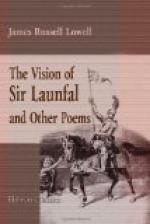193. Fretwork: The ornamental work carved in intricate patterns, in oak or stone, on the ceilings of old halls and churches.
195. Sharp relief: When a figure stands out prominently from the marble or other material from which it is cut, it is said to be in “high relief,” in distinction from “low relief,” bas relief.
196. Arabesques: Complicated patterns of interwoven foliage, flowers and fruits, derived from Arabian art. Lowell had undoubtedly studied many times the frost designs on the window panes.
201. That crystalled the beams, etc.: That caught the beams of moon and sun as in a crystal. For “that” the original edition has “which.”
204. Winter-palace of ice: An allusion, apparently, to the ice-palace built by the Empress of Russia, Catherine II, “most magnificent and mighty freak. The wonder of the North,” Cowper called it. Compare Lowell’s description of the frost work with Cowper’s similar description in The Task, in the beginning of Book V.
205-210. ’Twas as if every image, etc.: Note the exquisite fancy in these lines. The elves have preserved in the ice the pictures of summer foliage and clouds that were mirrored in the water as models for another summer.
211. The hall: In the old castles the hall was always the large banqueting room, originally the common living room. Here all large festivities would take place.
213. Corbel: A bracket-like support projecting from a wall from which an arch springs or on which a beam rests. The poet has in mind an ancient hall in which the ceiling is the exposed woodwork of the roof.
214. This line at first read: “With the lightsome,” etc. Why did Lowell’s refining taste strike out “the”?
216. Yule-log: The great log, sometimes the root of a tree, burned in the huge fireplace on Christmas eve, with special ceremonies and merrymakings. It was lighted with a brand preserved from the last year’s log, and connected with its burning were many quaint superstitions and customs. The celebration is a survival through our Scandinavian ancestors of the winter festival in honor of the god Thor. Herrick describes it trippingly in one of his songs:
“Come, bring with a
noise,
My merrie, merrie boys,
The Christmas log to the firing;
While my good dame, she
Bids ye all be free,
And drink to your heart’s desiring.”
219. Like a locust, etc.: Only one who has heard both sounds frequently can appreciate the close truth of this simile. The metaphors and similes in this stanza are deserving of special study.
226. Harp: Prof. William Vaughn Moody questions whether “the use of Sir Launfal’s hair as a ‘harp’ for the wind to play a Christmas carol on” is not “a bit grotesque.” Does the picture of Sir Launfal in these two stanzas belong in the Prelude or in the story in Part Second?




